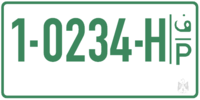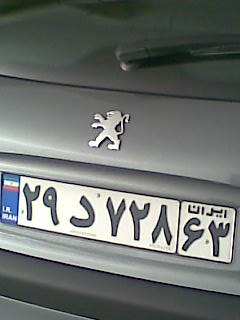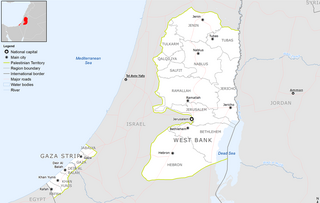West Bank
Generally, registration plates in the West Bank have the Latin letter "P" for Palestine or Palestinian Authority on the strip in the right side; above that, the Arabic letter ف (Faa') for فلسطين (Falasteen) or السلطة الفلسطينية (a-Sultat al-Filastiniya).
Private vehicles since July 2018
The Palestinian Authority's Ministry of Transport has announced a new numbering system for vehicles registered as of July 2018. According to the new method, vehicles will have a 6-character license number, which includes 5 digits and one Latin letter (as opposed to the previous system where the license number was 7 digits). The change in format was done because the code assigned to Ramallah Governorate was running out of possible combinations. [1] The proposed system will be in the #-####-X format, with the first five digits running in a serial fashion. The last letter in the number will be determined according to the governorate in which the vehicle was registered, and may be: [2]
- The letter A – Jenin
- The letter B – Tulkarm
- The letter C – Tubas
- The letter D – Nablus
- The letter E – Qalqilya
- The letter F – Salfit
- The letter G – Jericho
- The letter H – Ramallah
- The letter J – Jerusalem
- The letter K – Bethlehem
- The letter L – Hebron, Hebron Governorate
- The letter M – Dura, Hebron Governorate
- The letter N – Yatta, Hebron Governorate
The following letters are reserved for the Gaza Strip but have not been implemented yet, as the authorities in Gaza have implemented a different format since 2012:
- The letter P – North Gaza (Jabalia)
- The letter Q – Gaza
- The letter R – Deir al-Balah
- The letter S – Khan Yunis
- The letter T – Rafah
| Private vehicle registration plate since 2018: standard size, 520×110 mm |
| Private vehicle registration plate since 2018, installed on imported vehicles that cannot accommodate a standard 1-line plate: size compliant with the 300×150 mm American standard |
Motorcycle license plates have the same format and are treated as private vehicles, but are issued in two dimensions appropriate for the rear of a motorcycle.
| Motorcycle registration plate since 2018: 1-line design, 200×100 mm |
| Motorcycle registration plate since 2018: 2-line design, 165×165 mm |
Private vehicles between 1994 and July 2018
With the implementation of the Oslo II Accord and the transfer of some of the civil responsibilities in the occupied West Bank and Gaza Strip from Israeli Civil Administration to the Palestinian National Authority in 1994, a new license plate format was introduced to replace the existing format that had been issued by the Israeli Civil Administration.
Private vehicles had white plates with green numbers, the numbers have seven digits, the first shows the district (governorate) of the registration:
Y-XXXX-ZZ
- where Y indicates the district (governorate) and can be:
- 1: Gaza Strip, for vehicles registered prior to 1995 (North Gaza, Gaza, Central Gaza, Khan Yunis and Rafah Governorates)
- 3: Gaza Strip, for vehicles registered after 1995 (North Gaza, Gaza, Central Gaza, Khan Yunis and Rafah Governorates) — the initial "3" has been kept after the introduction of the present license plate system in 2012
- 4: Northern West Bank, for vehicles registered prior to 1995 (Jenin, Nablus, Qalqilya, Salfit, Tubas and Tulkarm Governorates)
- 5: Central West Bank, for vehicles registered prior to 1995 (Ramallah, Jerusalem and Jericho Governorates)
- 6: Central West Bank, for vehicles registered after 1995 (Ramallah, Jerusalem and Jericho Governorates)
- 7: Northern West Bank, for vehicles registered after 1995 (Jenin, Nablus, Qalqilya, Salfit, Tubas and Tulkarm Governorates)
- 8: Southern West Bank, for vehicles registered prior to 1995 (Bethlehem and Hebron Governorates)
- 9: Southern West Bank, for vehicles registered after 1995 (Bethlehem and Hebron Governorates)
- X can be any 4-digit number.
- ZZ
- For privately-owned vehicles, "ZZ" can be 40 to 49 and 90 to 98.
- Generally, vehicles owned by the Palestinian Authority carry the code 99.
- For vehicles that were registered prior to 1995 (district codes 1, 4, 5, and 8), "ZZ" corresponds to the year in which the car was first registered:
- 77 to 79 respectively for vehicles registered from 1967 to 1969
- 70 to 76 respectively for vehicles registered from 1970 to 1976
- 37 to 39 respectively for vehicles registered from 1977 to 1979
- 40 to 49 respectively for vehicles registered from 1980 to 1989
- 90 to 95 respectively for vehicles registered from 1990 to 1995
- For public for-hire vehicles, "ZZ" is 30
- For duty and tax-free vehicles (such as ambulances), "ZZ" is 31
- For vehicles leased with the extension, "ZZ" is 32
| Private vehicle registration plate from 1994 to 2018: standard size, 520×110 mm (formerly used in the Gaza Strip until 2012) |
| Private vehicle registration plate from 1994 to 2018, installed on imported vehicles that cannot accommodate a standard 1-line plate: size compliant with the 300×150 mm American standard |
For the first few years of issuance of this format until 2005, the shape and design of the license plate was slightly different. The positioning and the style of the Arabic letter "ف" and the English letter "P" on the right hand side differed, with the Arabic letter being on the bottom and "P" on the top. The license plate also featured an embossed green Eagle of Saladdin, the official emblem of Palestine.
| Private vehicle registration plates from 1994: earlier style, standard size, 520×110 mm |
| Private vehicle registration plate from 1994; earlier style, installed on imported vehicles that cannot accommodate a standard 1-line plate: size compliant with the 300×150 mm American standard |
Motorcycle license plates had the same format and were treated as private vehicles, but were issued in two dimensions appropriate for the rear of a motorcycle.
| Motorcycle registration plate from 1994 to 2018: 1-line design, 200×100 mm |
| Motorcycle registration plate from 1994 to 2018, 2-line design, 165×165 mm |
Public transport
Public transport vehicles such as taxis, shared taxis and buses have green plates with white numbers. Taxi plates always end in "30".
| Public vehicle registration plate from 1994: standard size, 520×110 mm (used in the Gaza Strip until 2012) |
Plates for government vehicles


Vehicles belonging to the Palestinian Authority such as officials' cars, ambulances, fire brigade police and special military police use white number plates with red numbers in the XXXX format with leading zeros.[ dubious ]
| Government vehicle registration plate from 1994: standard size, 520×110 mm (used in the Gaza Strip until 2012) |
For the first few years of issuance of this format until 2005, the shape and design of the license plate was slightly different.
| Government vehicle registration plate from 1994: standard size, 520×110 mm (used in the Gaza Strip until 2012) |
Currently, newly-registered police vehicles receive green-on-white plates ending in "99".
Stolen vehicle plates
This class of license plates, unique in the world, is the outcome of the complications related to the Israeli–Palestinian peace process.
With the signing of Gaza–Jericho Agreement, establishment of the Palestinian Civil Police Force, and replacement of Israel Police in most areas of the Gaza Strip with the former, Israeli car thieves fenced about 15,000 stolen cars into the Gaza Strip, where they were then sold away from the reach of Israel Police. Israeli car owners, unable to retrieve their cars, would be reimbursed by their insurance, and they would buy new cars. In effect, this resulted in Israeli insurance companies paying for Gaza's used car trade. When the insurance companies sued, the Palestinian Authority settled and the settlement cost was offset in part by increased registration fees for cars that had been stolen: to designate those cars, they were given special license plates. These license plates had black texts and black borders on a white background. On the right hand side, instead of having the "P / ف" national identifiers, as was the norm with other types of registration plates, they had "ف / م". The Arabic letter "م" stands for المقيدة, meaning "restricted", and was effectively a euphemism referring to the vehicle's origins. By 2005, the Palestinian Authority phased this class of license plates out and replaced them with typical license plates. [3]
The format of these license plates was YY-XXX, where YY could have been:
- 25 for government vehicles
- 26 for police vehicles
- 27-30 for privately owned vehicles
| Stolen vehicle registration plate from 1994: standard size, 520×110 mm (used until 2005) |
Test plates

Test plates for garages and car importers are blue with white text and display the word "TEST" in Arabic (اختبار) and Hebrew (במבחן) above the number.





























